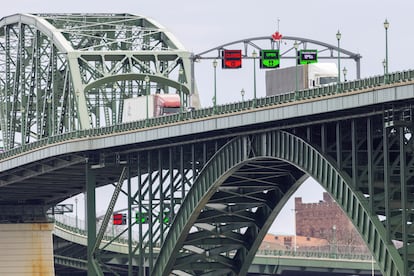Canada is not backing down and accepts the challenge from its southern neighbor: this is how it plans to stand up to Donald Trump.


Mark Carney's Liberals swept to victory in the Canadian elections on April 28, in a campaign centered on the trade war with the United States. In his speech after his victory, Carney stated: "President [Donald] Trump is trying to break us so that the United States can own us. That will never happen, but we must also recognize that our world has changed. Our old relationship with the United States, a relationship based on ever-increasing integration, is over." The election results showed that Canadians trust Carney —former governor of the Bank of Canada and the Bank of England—to address this climate of hostility. However, the United States had already been taking action to counter this complex situation.
Former Prime Minister Justin Trudeau announced in early February that the country would respond to the tariffs imposed by Washington with the same approach. Carney, now the new Liberal leader and acting prime minister, did the same on April 3 regarding the vehicle tariffs imposed by Trump. This exchange of tariff attacks is taking place in a climate of high uncertainty, a hallmark of the Republican administration , in which temporary suspensions may be announced, only to pull a new list of tariffs out of the hat the next day. In the Canadian case, tariffs are not the only response.
In recent weeks, political authorities at various levels, business associations, and social media groups have called for priority purchases of Canadian products; in many cases, they even call for boycotts of products from the United States. The public's reaction has not been exactly lukewarm. A survey conducted by Dalhousie University found that 61% of Canadians surveyed are willing to buy food produced in the country even if it is 10% to 15% more expensive. In another survey, conducted by Nanos Research, 12% said they had canceled their subscriptions to American entertainment platforms, while 34% said they avoided establishments such as Costco, Starbucks, and McDonald's.
Supermarkets, car dealerships, clothing stores, and other businesses are making efforts to help customers identify Canadian products on the shelves. Some digital tools are proving very useful when visiting these stores. One of them is the "Buy Beaver" app, which evaluates each product based on three criteria: place of manufacture, origin of ingredients or manufacturing materials, and the nationality of the brand owner. Another is "Maple Scan," which, among other features, provides alternatives to Canadian products when scanning a foreign product.
Not only is there a change in stores; Canadians are also traveling less to their neighboring country. According to Statistics Canada, the number of people returning overland from the United States last March fell by 31.9% compared to the same month the previous year. Meanwhile, the analysis firm OAG reported a nearly 72% drop in flight bookings from Canada to the United States for the next six months, compared to figures for the same period in 2024. According to OAG, this data suggests "that travelers are postponing their reservations, likely due to uncertainty related to the trade conflict."
Despite these actions, it remains a daunting task to significantly reduce—and in a short period of time—the trade volume between Canada and the United States. In 2024, 76% of Canadian exports went to the neighboring country, while 62% of imports were from the United States. However, the goal is to gradually increase interaction with other markets. Carney stated on April 28 that there are options other than the United States "to build prosperity for all Canadians." Carney added: "We will strengthen our relationships with reliable partners in Europe, Asia, and beyond." Officials emphasize that Canada currently has 15 free trade agreements with 50 other countries.
Efforts are also being made to incentivize trade within the country. In February, the federal government eliminated half of the exceptions contemplated in the interprovincial free trade agreement. A month later, the premiers of all provinces pledged to reduce barriers to these exchanges. Doug Ford, premier of Ontario—Canada's most populous province and one with the greatest industrial drive —announced a bill on April 16 to eliminate all trade barriers with other provinces. "Much like President Trump's tariffs, these trade barriers hurt our economy, drive away jobs and investment, and create divisions among ourselves," Ford said. Carney has said he will propose eliminating the remaining federal obstacles.
Deceleration“Trump's harsh tariff measures will shake the Canadian economy,” indicates an analysis prepared by experts at the Bank of Montreal. According to the document, these tariffs—if applied over the course of a year—could cause a contraction of the Canadian economy for two quarters, “reducing real GDP growth by 1.5 percentage points.” The bank's economists also predict around 100,000 job losses in the country, with an unemployment rate that could reach 8% by the end of the year. They also note that “inflation should rise as the Canadian dollar weakens.”
In his campaign plan, Carney (who will meet with Trump tomorrow, Tuesday) promised a response fund for businesses and workers worth approximately 2 billion Canadian dollars for the next fiscal year, as well as a 5 billion dollar trade corridor diversification plan. Carney's Liberals won the election, but fell three seats short of forming a majority government. Therefore, they must secure the support of one of the three opposition parties to pass their initiatives. Carney also promised that he would ask Washington to renegotiate the bilateral relationship, insisting that it will be a renegotiation between "two sovereign nations."
EL PAÍS





